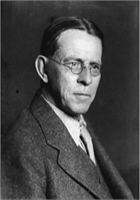Occupation Journalist, lecturer Role Poet Siblings Patrick Abercrombie | Name Lascelles Abercrombie Children Michael Abercrombie | |
 | ||
Education University of Manchester, Malvern College Books Emblems of Love, The poems of Lascelles, Interludes and poems, The Epic An Essay, An essay towards a theory of | ||
Lascelles Abercrombie Life & Works
Lascelles Abercrombie: Poetry is the work of poets, not of peoples or communit ......
Lascelles Abercrombie (/ˈaebərˌkrɒmbi, -ˌkrvm-/; also known as the Georgian Laureate, linking him with the "Georgian poets"; 9 January 1881 – 27 October 1938) was a British poet and literary critic, one of the "Dymock poets".
Contents
- Lascelles Abercrombie Life Works
- Lascelles Abercrombie Poetry is the work of poets not of peoples or communit
- Biography
- Family
- Archives
- Quotes
- References
Biography
He was born in Ashton upon Mersey, Sale, Cheshire.and educated at Malvern College, and at Owens College.
Before the First World War, he lived for a time at Dymock in Gloucestershire, part of a community that included Rupert Brooke and Robert Frost. Edward Thomas visited. During these early years, he worked as a journalist, and he started his poetry writing. His first book, Interludes and Poems (1908), was followed by Mary and the Bramble (1910) and the poem Deborah, and later by Emblems of Love (1912) and Speculative Dialogues (1913). His critical works include An Essay Towards a Theory of Art (1922), and Poetry, Its Music and Meaning (1932). Collected Poems (1930) was followed by The Sale of St. Thomas (1931), a poetic drama.
During World War I, he served as a munitions examiner, after which, he was appointed to the first lectureship in poetry at the University of Liverpool. In 1922 he was appointed Professor of English at the University of Leeds in preference to J. R. R. Tolkien, with whom he shared, as author of The Epic (1914), a professional interest in heroic poetry. In 1929 he moved on to the University of London, and in 1935 to a prestigious readership at Oxford University. He wrote a series of works on the nature of poetry, including The Idea of Great Poetry (1925) and Romanticism (1926). He published several volumes of original verse, largely metaphysical poems in dramatic form, and a number of verse plays. Abercrombie also contributed to Georgian Poetry and several of his verse plays appeared in New Numbers (1914). His poems and plays were collected in 'Poems' (1930).
Lascelles Abercrombie died in London in 1938, aged 57, from undisclosed causes.
Family
He was the brother of the architect Patrick Abercrombie and the father of the phonetician David Abercrombie and the cell biologist Michael Abercrombie. A grandson, Jeffrey Cooper, produced an admirable bibliography of his grandfather, with brief but important notes, while a great-grandson is author Joe Abercrombie.
Archives
A collection of literary and other manuscripts relating to Abercrombie is held by Special Collections in the Brotherton Library at the University of Leeds. The collection contains drafts of many of Abercrombie's own publications and literary material; lecture notes, including those of his own lectures and some notes taken from the lectures of others, and a printed order of service for his Memorial Service in 1938.
Special Collections in the Brotherton Library also holds correspondence relating to Lascelles Abercrombie and his family. Comprising 105 letters, the collection contains letters of condolence to Catherine and Ralph Abercrombie on the death of Lascelles, as well as Abercrombie family letters from various correspondents, chiefly to Ralph Abercrombie.
Quotes
Epic poetry exhibits life in some great symbolic attitude It cannot strictly be said to symbolize life itself - but always some manner of life
An epic is not made by piecing together a set of heroic lays - adjusting their discrepancies and making them into a continuous narrative
If epic poetry is a definite species - the sagas do not fall within it
